Part of a series of articles titled Intermountain Park Science 2021.
Article • Intermountain Park Science 2021
The Dragonfly Mercury Project: Citizen Science in Action at Glen Canyon National Recreation Area
- Katherine Ko, Geoscientists-in-the-Parks Intern, Glen Canyon National Recreation Area, National Park Service (currently Biologist, Air Resources Division, National Park Service)
- Lonnie Pilkington, Natural Resources Program Manager, Glen Canyon National Recreation Area, National Park Service (currently Vegetation Program Manager, Grand Canyon National Park, National Park Service)
-
Colleen Flanagan Pritz, Ecologist, Air Resources Division, National Park Service
- Sarah J. Nelson, Director, Program in Ecology and Environmental Science, University of Maine (currently Director of Research, Appalachian Mountain Club)
-
Collin Eagles-Smith, Supervisory Research Ecologist, Forest and Rangeland Ecosystem Science Center, US Geological Survey
-
James Willacker, Ecologist, Forest and Rangeland Ecosystem Science Center, US Geological Survey
-
Colleen Emery, Ecologist, Forest and Rangeland Ecosystem Science Center, US Geological Survey
Abstract
Since 2009, the Dragonfly Mercury Project (DMP) has connected citizen scientists with national parks in a nationwide effort to understand the risks associated with mercury in the environment. To date, 121 park units and more than 5,000 citizen scientists have contributed over 20,000 hours of service to the study. Glen Canyon National Recreation Area participated in the DMP for the first time in 2018, working with 5 youth organizations to sample dragonfly larvae from aquatic habitats throughout the park. The samples were then shipped to the U.S. Geological Survey laboratory in Corvallis, Oregon, where they are analyzed for total mercury concentrations. The park-wide and project-wide results show that while most sampling sites are at relatively low risk for mercury impairment, 12 percent of the sites are at higher risk. These results offer insight on potential risk associated with mercury and help inform management decisions to safeguard human and wildlife health. The DMP encourages public interest in biodiversity and participatory science while contributing to applied research on air quality and mercury risk. As the project continues to grow, we encourage parks old and new to participate in this groundbreaking citizen science study.
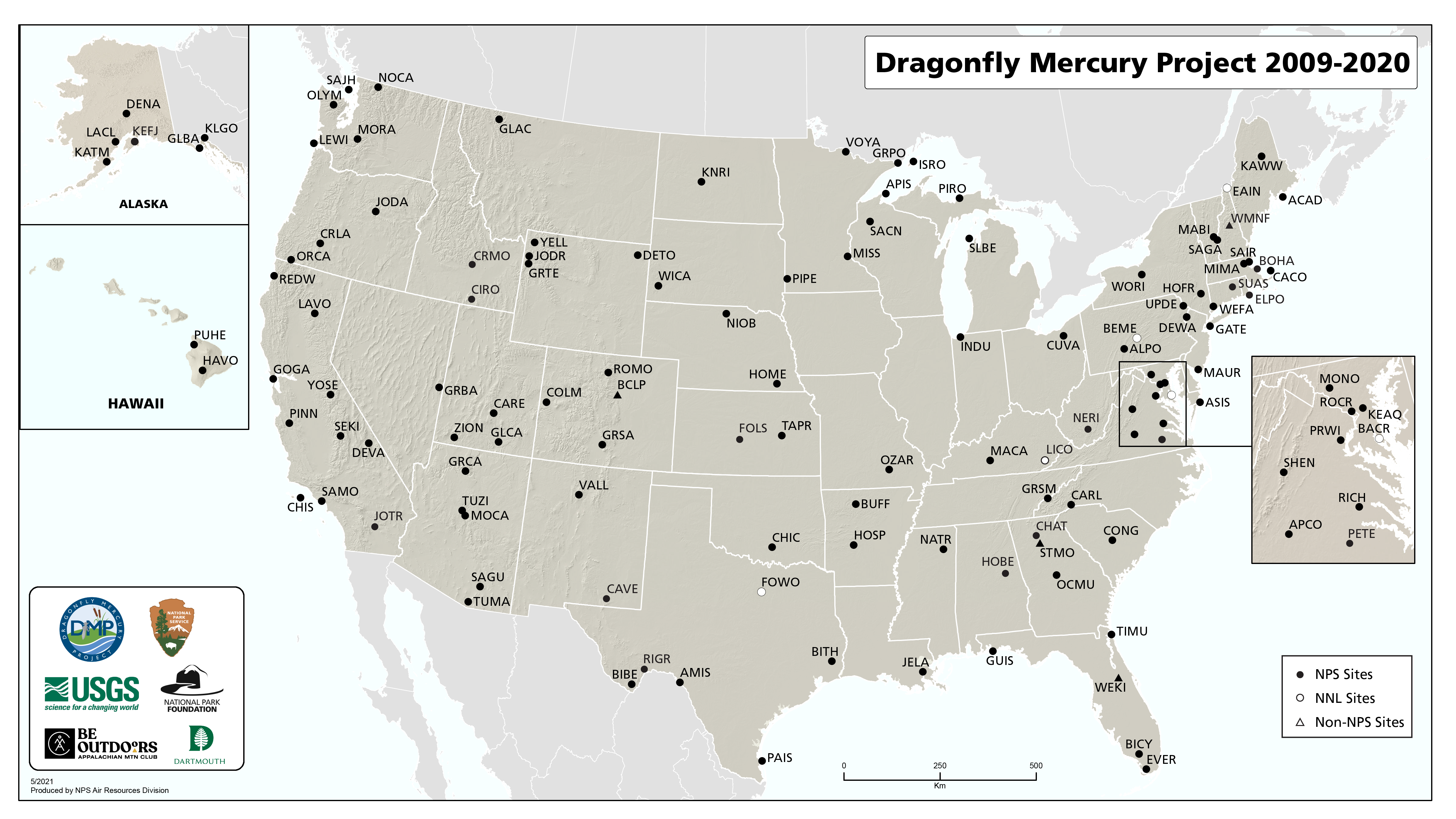
NPS Air Resources Division.
Background
The Dragonfly Mercury Project (DMP) is a nationwide study that engages citizen scientists (members of the public who volunteer to contribute to the scientific process) in the collection of dragonfly larvae in national parks for mercury analysis. This study investigates mercury accumulation and potential risk in parks while engaging local citizen scientists in environmental research and stewardship. The data generated on mercury concentrations are publicly available and help resource managers and agencies make informed decisions to protect human and wildlife health. To date, 121 park units and more than 5,000 citizen scientists have contributed over 20,000 hours of service to the DMP (Figure 1).
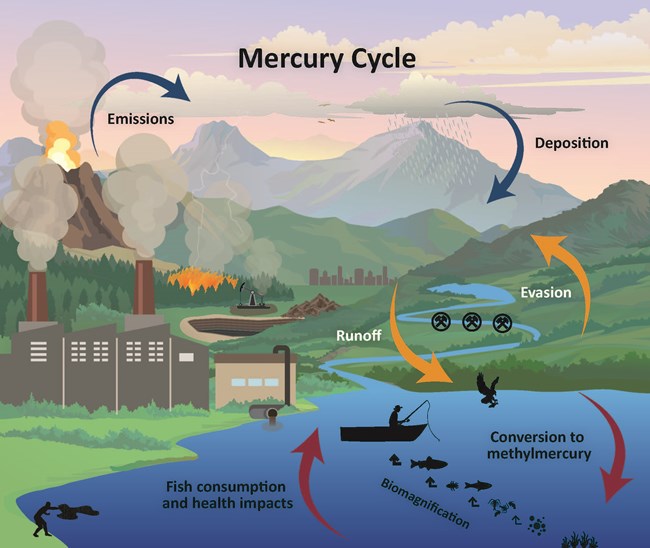
NPS Air Resources Division.
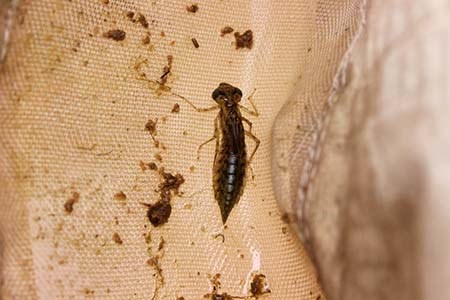
NPS/Brad Jorgensen.
Dragonfly larvae can be used as biosentinels, or indicators, of mercury contamination in aquatic food webs (Figure 3). The juvenile dragonflies live underwater for months-to-years as predatory larvae, eating smaller insects and accumulating mercury from that food (Nelson et al. 2015). Dragonfly larvae are also important prey for fish, amphibians and birds, facilitating the transfer of mercury through the food web that may eventually pose health risks to humans as a result of fish consumption. Therefore, sampling and analyzing mercury concentrations in dragonfly larvae can indicate the potential risk for mercury impairment in the larger ecosystem.
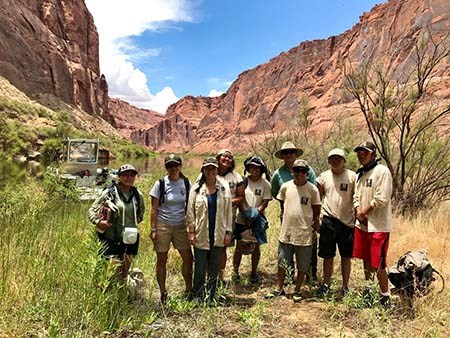
NPS photo.
Sampling in Glen Canyon National Recreation Area
In 2018, Glen Canyon National Recreation Area was a first-time participant in the DMP, contributing to the list of more than 100 park units to date. Glen Canyon biologists enlisted the help of five youth organizations to assist with dragonfly larvae sampling: Grand Canyon Youth Middle School Adventure, Page Boy Scout Troop 7911, Page Girl Scout Troop 7489, Page High School, and the Southwest Conservation Corps Ancestral Lands Native Conservation Corps (Figure 4). A total of 53 students and 23 adult leaders participated in sampling and dedicated a total of 231 hours to the project at Glen Canyon in 2018.

Between June and August, park staff worked with citizen scientists to sample five sites (from west to east): Lone Rock Beach, The Slough (adjacent to the Colorado River), Bowns Canyon, Ribbon Canyon, and Slickhorn Canyon (adjacent to the San Juan River) (Figure 5). These sites were chosen for their reliable populations of dragonfly larvae and their wide geographical and altitudinal ranges throughout the park.

NPS photo.
Sampling Methods
At each site, the citizen scientists assisted in recording site characteristics describing physical structure, vegetation, and geology. Dragonfly larvae were then sampled using D-frame dip nets – the nets were swept through vegetation and sediments below the water, where the dragonfly larvae live (Figure 6).

National Geographic photo.
Each dragonfly larva was handled using clean techniques to prevent contamination, and placed in a small plastic bag, measured to the nearest millimeter, and identified to family using field cards provided by the DMP (Figure 7). Identifications were later validated in the lab by professional staff trained in Odonata (the order that includes dragonflies and damselflies) identification. Determining the dragonfly family is important because different families vary slightly in diet, habitat, and physiology, which could contribute to differences in mercury concentrations. However, researchers were able to statistically model mercury variation at the family level, allowing for direct comparison across families (Eagles-Smith et al. 2020b, Flanagan Pritz et al. 2014). Citizen scientists also recorded data describing the physical and identifying characteristics of each individual, as well as linking the information back to the location from which the larva was sampled. Once all samples were collected, they were stored in a freezer until shipment to the U.S. Geological Survey laboratory in Corvallis, OR for mercury analysis.
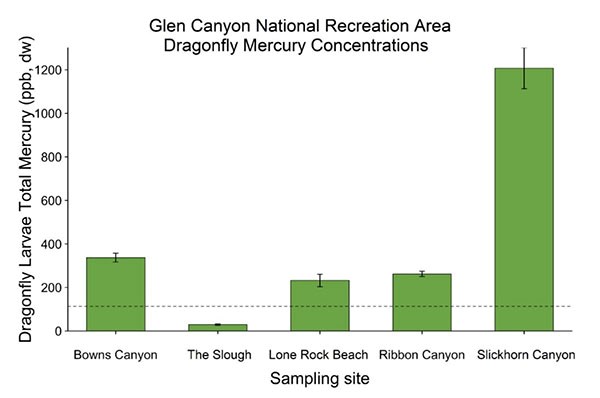
Eagles-Smith et al. 2019.
Results
The mercury concentrations found in dragonfly larvae collected from Glen Canyon in 2018 vary widely among sampling sites. The total mercury concentrations found in dragonfly larvae for each Glen Canyon site are as follows: Bowns Canyon: 346 ppb, dw (parts per billion, dry weight); The Slough: 32 ppb, dw; Lone Rock Beach: 252 ppb, dw; Ribbon Canyon: 266 ppb, dw; and Slickhorn Canyon: 1252 ppb, dw (Figure 8). The park-wide average mercury concentration was 241 ± 54 ppb, dw, which is more than twice as high as the 2018 project-wide average across all 100 parks, which was 113 ppb, dw (Eagles-Smith et al. 2019). Project-wide data gathered by the DMP since 2009 reveal that dragonfly larvae mercury concentrations can vary by up to 44-fold within parks and 135-fold among parks (Eagles-Smith et al. 2020b).
The mercury concentration found at each sampling site also places the site in one of five impairment categories for risk of mercury toxicity: sub-impairment, low-impairment, moderate-impairment, high-impairment, or severe-impairment. Of the sites sampled at Glen Canyon in 2018, one was in the sub-impairment category (The Slough), two were in the moderate-impairment category (Lone Rock Beach and Ribbon Canyon), one was in the high-impairment category (Bowns Canyon), and one was in the severe-impairment category (Slickhorn Canyon) for mercury risk (Eagles-Smith et al. 2020a).
Discussion
A decade of dragonfly mercury analysis through this study reveals that while mercury risk is relatively low among national parks, specific sites with elevated mercury concentrations still exist and are widely distributed across the United States. (Eagles-Smith et al. 2016). The 2018 data results from Glen Canyon support the project-wide observation that mercury concentrations can vary greatly even within one park, emphasizing the importance of landscape characteristics. It is interesting to note that all the sites sampled in Glen Canyon are hydrologically connected: the San Juan River and Colorado Rivers converge and then flow into Lake Powell. However, even though the same water may flow through all these sites, there are nevertheless marked differences in dragonfly mercury concentrations.
This wide range of mercury concentrations suggests that different site characteristics and landscapes may facilitate the conversion of mercury to toxic methylmercury at different rates. Therefore, although sources of air pollution— like coal-fired power plants— are an important factor in mercury deposition, the features of a specific landscape (e.g. plants, elevation, geology, hydrology, water chemistry, etc.) that facilitate the conversion and buildup of methylmercury are also extremely important in determining how much of the toxin ends up in any specific habitat—and ultimately, in the food chain.
The publicly available data generated by this study help inform the decisions made by resource managers and agencies to protect human and wildlife health. While most of the 457 sites sampled for the entire project between 2009-2018 show moderate to low risk for mercury, 12% of sites sampled across the board are at high or severe risk for mercury impairment (Eagles-Smith et al. 2020b). The results from Glen Canyon in 2018 showed Bowns Canyon and Slickhorn Canyon in the high-impairment and severe-impairment categories, respectively.
Sites that are at higher risk for mercury impairment could mean potential risk to humans. These risk categories were determined in part by how many existing wildlife risk benchmarks are exceeded by the mercury concentration in question; the more benchmarks exceeded, the higher the potential mercury risk (Eagles-Smith et al. 2020b). In other words, if one site has dragonfly larvae mercury concentrations that exceed an existing fish health benchmark, then wildlife and people who eat fish from that site could be at an elevated risk for mercury impairment. It is therefore imperative for researchers to continue studying mercury in dragonfly larvae to predict potential risk to humans and wildlife and provide tools for resource managers to assess and mitigate this risk.
Expanding the Dragonfly Mercury Project
Each year, the DMP continues to reach more parks and citizen scientists (Figure 9). In 2018, park staff and citizen scientists collected dragonfly larvae from 143 sites across 57 National Park Service units and National Natural Landmarks across the country, bringing the project’s running total of participating parks to 102 units. In 2019, that total reached 107 units, and the 2020 season brought the grand total to 121 units to date. Since 2009, over 5,000 citizen scientists have contributed more than 20,000 hours of service to the project. The DMP continues to expand the geographic coverage of the project by partnering with new units while also engaging returning parks in long-term monitoring.

Figure adapted from Dragonfly Mercury Project 2020.
The project continues to investigate how different landscapes and environmental processes might disproportionately affect rates of methylmercury buildup. These data support a more informed understanding of mercury risk and its drivers in a particular area, which could lead to the development of tools for mitigating such risk.
Entering its second decade of programming, the DMP continues to expand and engage more sites and citizen scientists. In 2018, a Steering Committee was formed with members of the National Park Service, U.S. Geological Survey, U.S. Fish and Wildlife Service, and U.S. Environmental Protection Agency, with the goal of developing strategies for expanding the scope to new partners, landscapes, and research questions.
The Dragonfly Mercury Project is a true testament to collaboration and engagement of the public in scientific research. The unique experience of collecting dragonfly larvae in a national park brings people closer to nature and helps foster the next generation of scientists, stewards, and outdoor enthusiasts. This project brings together multiple federal agencies, academic scientists, non-governmental organizations, and public participants to protect our nation’s natural resources.
This has resulted in generating a decade’s worth of data on mercury pollution covering water bodies in 47 states, including Alaska and Hawaii. Engaging local communities in environmental stewardship is crucial to building relationships and inspiring the next generation. Citizen science programs like the Dragonfly Mercury Project are more than just a means to collect data— they are an investment in the future of our planet.
For Additional Information Please Visit
Dragonfly Mercury Project webpage: Available at: https://go.nps.gov/dragonflymercury (accessed October 16, 2020)
Interactive Story Map: Available at: https://wim.usgs.gov/geonarrative/dmp/ (accessed October 16, 2020)
DMP Data Map: Available at: https://www.nps.gov/articles/dragonflymercury-map.htm (accessed October 16, 2020)
Successes of Citizen Science and the DMP: Available at: https://www.nps.gov/articles/citizen-science-success-dmp.htm (accessed October 16, 2020)
Distance Learning with the DMP: Available at: https://www.nps.gov/articles/dragonfly-mercury-project-distance-learning.htm (accessed October 16, 2020)
Acknowledgements
Thank you to everyone who has helped make the Dragonfly Mercury Project possible: National Park Service, USGS Environmental Health Mission Area, USGS-NPS Water Quality Partnership, National Oceanic and Atmospheric Administration (NOAA) Bay Watershed Education and Training (B-WET) Program, University of Maine Faculty Research Funds, Maine Department of Education, Appalachian Mountain Club, National Park Foundation, NPS staff in parks, regions, networks, Research Learning Centers; Megan Hess (UMaine), Abe Miller-Rushing (NPS), Hannah Webber (Schoodic Institute), staff at the USGS contaminant ecology research lab, Roger Haro (UW-LAX), Celia Chen (Dartmouth), David Krabbenhoft (USGS), DMP Steering Committee, Grace Carpenter (NPS), Glen Canyon National Recreation Area staff, and greater than 5,000 participating citizen scientists.
References
Dragonfly Mercury Project. 2020.
Growing the Value and Impact of the Dragonfly Mercury Project: A Prospectus. (Eds) Flanagan Pritz, C., C. Eagles-Smith, S. Nelson, and A. Miller-Rushing. Available at https://irma.nps.gov/DataStore/DownloadFile/660023. 23 pp.
Eagles-Smith, C., S. J. Nelson, C. M. Flanagan Pritz, J. J. Willacker Jr., and A. Klemmer. 2019.
Total mercury concentrations in dragonfly larvae from U.S. national parks: U.S. Geological Survey Data Release. Available at: https://doi.org/10.5066/P9TK6NPT (accessed October 16, 2020)
Eagles-Smith, C. A., S. J. Nelson, J. J. Willacker, Jr., C. M. Flanagan Pritz, and D. P. Krabbenhoft. 2016.
Dragonfly Mercury Project—a citizen science driven approach to linking surface-water chemistry and landscape characteristics to biosentinels on a national scale. U.S. Geological Survey Fact Sheet 2016-3005. Available at: http://dx.doi.org/10.3133/fs20163005 (accessed October 16, 2020)
Eagles-Smith, C. A., J. J. Willacker Jr., S. J. Nelson, C. M. Flanagan Pritz, C. S. Emery, B. L. Johnson, K. Ko, D. P. Krabbenhoft, C. Y. Chen, J. T. Ackerman, E. H. Grant, and D. S. Pilliod. 2020a.
The Dragonfly Mercury Project- A citizen science framework for monitoring mercury pollution in US national parks using dragonfly larvae as biosentinels. USGS Story Map. https://wim.usgs.gov/geonarrative/dmp/ (accessed October 16, 2020)
Eagles-Smith, C. A., J. J. Willacker, S. J. Nelson, C. M. Flanagan Pritz, D. P. Krabbenhoft, C. Y. Chen, J. T. Ackerman, E. H. Campbell Grant, and D. S. Pilliod. 2020b.
A national-scale assessment of mercury bioaccumulation in United States National Parks using dragonfly larvae as biosentinels through a citizen-science framework. Environmental Science & Technology 54:8779-8790. Available at: https://pubs.acs.org/doi/10.1021/acs.est.0c01255 (accessed October 16, 2020)
Flanagan Pritz, C., C. Eagles-Smith, and D. Krabbenhoft. 2014.
Mercury in the National Parks. The George Wright Forum 31(2): 168-180. Available at: http://www.georgewright.org/312flanagan_pritz.pdf (accessed October 16, 2020)
National Park Service. 2018.
Dragonfly Mercury Project. Available at: https://go.nps.gov/dragonflymercury (accessed October 16, 2020)
Nelson, S. J., H. M. Webber, and C. M. Flanagan Pritz. 2015.
Citizen scientists study mercury in dragonfly larvae: dragonfly larvae provide baseline data to evaluate mercury in parks nationwide. Natural Resource Report NPS/NRSS/ARD/NRR—2015/938. National Park Service, Fort Collins, Colorado. Available at: https://irma.nps.gov/DataStore/DownloadFile/521133 (accessed October 16, 2020)
Last updated: March 1, 2023






